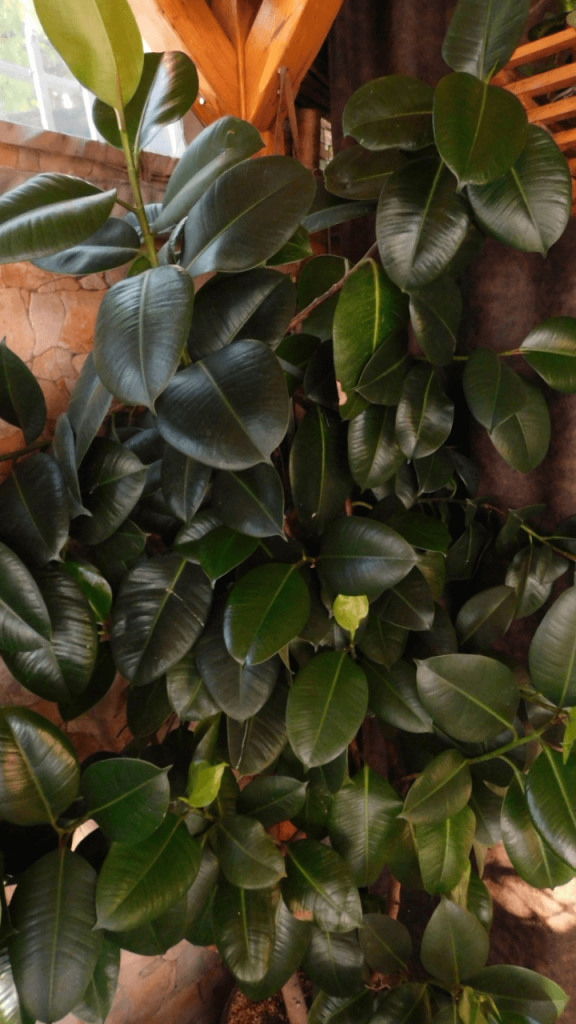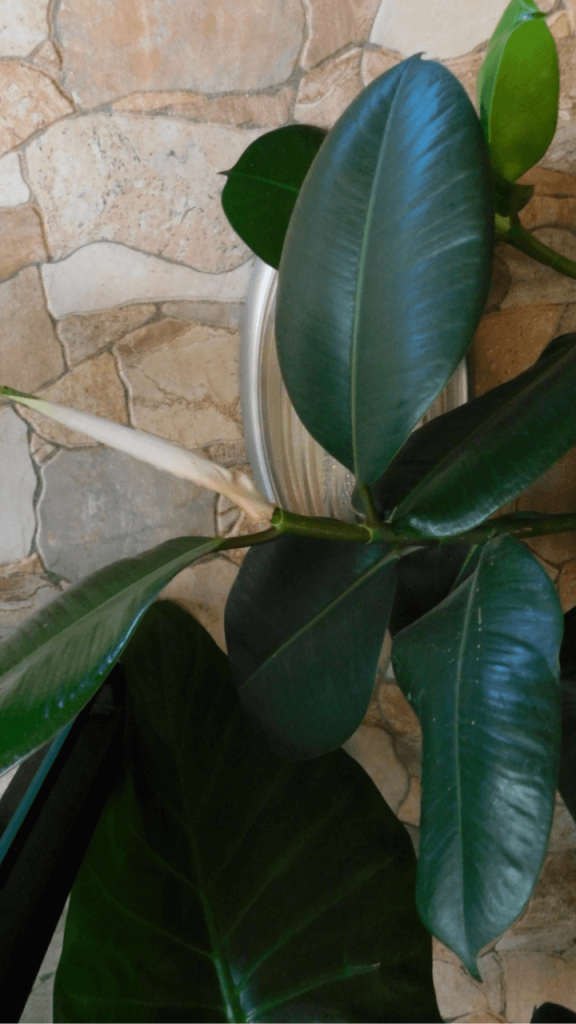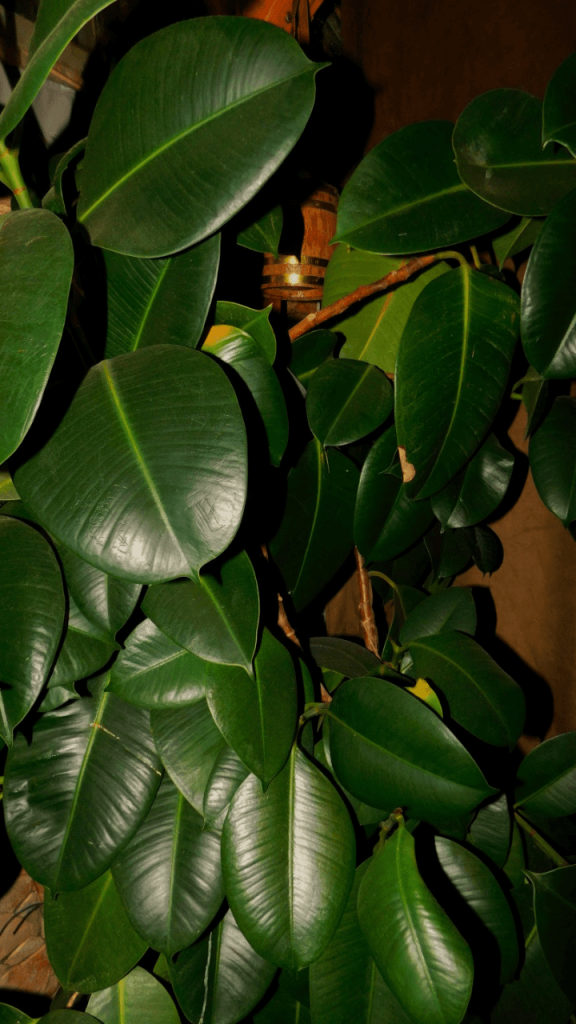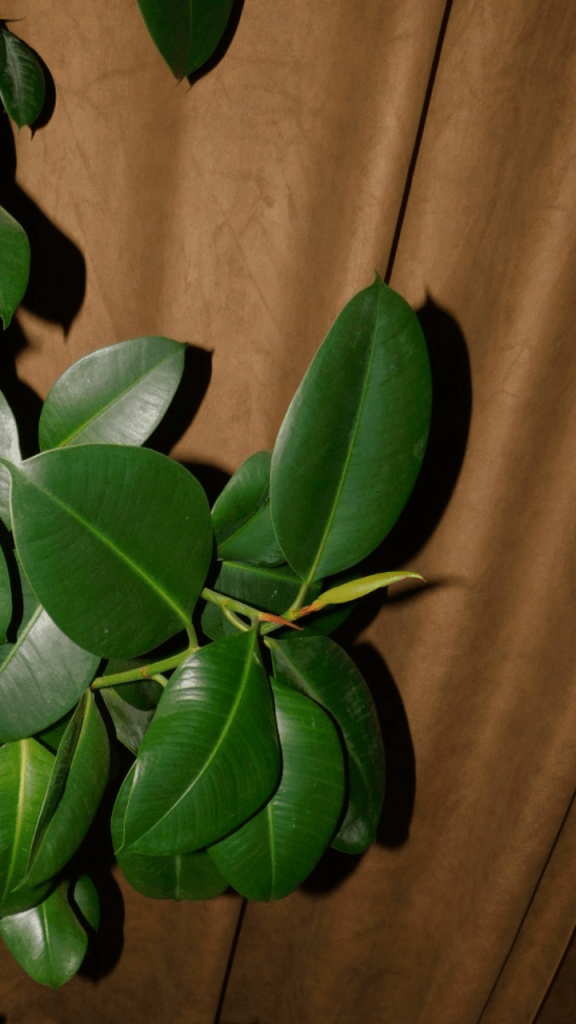Their large, dark green leaves, which can sometimes boast beautiful burgundy hues, are not just visually appealing but also efficient in processing indoor air, making them an excellent choice for those looking to enhance air quality in homes or offices. Rubber plants are highly adaptable and can flourish in both bright, indirect light and lower-light conditions, though they prefer the former for optimal growth. This adaptability makes them suitable for different areas of a home, from well-lit living rooms to less illuminated corners.
Watering a rubber plant is straightforward, as it requires only moderate watering—allowing the topsoil to dry out between waterings. Over-watering is a common mistake, so it’s essential to ensure good drainage. Furthermore, these plants enjoy a boost in humidity, so occasional misting or a pebble tray with water can create a more favorable environment, especially in drier climates or during winter months when indoor heating can reduce humidity levels.
Air pollution is a pervasive global issue that affects both outdoor and indoor environments. Indoor air quality is often overlooked, yet it can be equally detrimental to our health as outdoor pollution. Substandard air quality can contribute to a range of health problems, including allergies, asthma, and respiratory issues. To mitigate these risks, the inclusion of air purifiers becomes imperative in every household, as they play a crucial role in eliminating pollutants and enhancing indoor air quality.
Air purifiers effectively filter and remove harmful substances present in the air, such as dust, pet dander, pollen, mold spores, and volatile organic compounds (VOCs). By capturing these pollutants, air purifiers significantly reduce their concentration, thus minimizing the potential adverse effects on human health.

Overview of rubber plants and their air-purifying properties:
Rubber plants, scientifically known as Ficus elastica, have emerged as a sought-after houseplant in recent times due to their remarkable air-purifying abilities. These plants originate from the tropical regions of Southeast Asia and have been cherished for their ornamental value for centuries.
Research has indicated that rubber plants excel in filtering and cleansing the air, making them an asset to any indoor space. They have the capability to efficiently remove various airborne pollutants, including volatile organic compounds (VOCs) and toxins commonly found in household items such as cleaning products, furniture, and carpets. By actively absorbing these pollutants through their leaves, rubber plants contribute significantly to improving indoor air quality.
Beyond their air-purifying prowess, rubber plants exhibit an exquisite appearance that adds a touch of natural beauty to any room. Their glossy, dark green leaves and striking stature make them an appealing choice for both contemporary and traditional interior designs.
Thesis statement: Rubber plants are an easy-to-care-for plant that can effectively purify the air in your home.
Rubber plants are indeed an excellent choice for individuals seeking an air-purifying plant that requires minimal maintenance. Not only are they low maintenance, but they also boast remarkable proficiency in removing pollutants from the air, rendering them a valuable addition to any household. In this blog post, we will delve into the benefits of rubber plants as air-purifiers, provide insights on their care requirements, and offer tips on seamlessly incorporating them into your home decor.
As air-purifiers, rubber plants have gained acclaim for their ability to effectively filter and cleanse indoor air. They excel at removing common pollutants, including volatile organic compounds (VOCs) and other toxins that can be found in various household items such as cleaning products, furniture, and carpets. By actively absorbing and neutralizing these harmful substances through their leaves, rubber plants contribute significantly to improving indoor air quality and promoting a healthier living environment.
Rubber plants prefer well-draining soil and should be watered when the top inch of soil becomes dry. It’s important to strike a balance with watering, as overwatering can lead to root rot, while underwatering can cause the leaves to wilt and drop. Regular wiping of the leaves with a damp cloth helps to remove dust and keep them clean, which aids in optimal air purification.
Incorporating rubber plants into your home decor is a delightful way to enjoy their air-purifying benefits while adding a touch of natural beauty. With their large, glossy leaves and appealing stature, rubber plants effortlessly enhance the aesthetics of any living space. Consider placing them in well-lit areas such as living rooms, bedrooms, or home offices, where they can serve as focal points or complement existing interior design elements.
Rubber Plants 101

Rubber plants possess a rich and captivating history. Originating from Southeast Asia, these plants were initially encountered by European explorers during the 17th century. Their significance extends beyond their ornamental value, as they played a pivotal role in the production of natural rubber, a valuable resource utilized across various industries.
The sap of the rubber plant proved to be a vital source of natural rubber. This versatile material found extensive applications in industries such as manufacturing, transportation, and construction. Its elasticity, durability, and waterproof properties made it an indispensable component in the production of tires, belts, hoses, and countless other products.
Today, rubber plants continue to captivate plant enthusiasts and serve as a reminder of their historical significance and contribution to various domains.
These plants, native to Southeast Asia, played a crucial role in the production of natural rubber, which revolutionized numerous industries. Their historical significance further adds to the allure and fascination associated with rubber plants.
Ideal growing conditions for rubber plants:
Rubber plants, scientifically known as Ficus elastica, flourish in environments that mimic their natural habitat, making them excellent choices for indoor cultivation. These plants thrive in warm and humid conditions, which can be easily achieved within the controlled environment of your home or office.
When it comes to light requirements, rubber plants prefer bright, indirect light. While they appreciate ample illumination, it’s important to shield them from direct sunlight, as it can lead to leaf scorching. Placing them near a window that receives filtered or diffused light is ideal to provide them with the appropriate lighting conditions for optimal growth.
Watering the rubber plant requires a delicate balance. It is advisable to wait until the top inch of the soil feels dry to the touch before watering. Overwatering should be avoided, as it can lead to root rot and other moisture-related issues. Regularly checking the soil’s moisture level and adjusting the watering frequency accordingly is crucial for maintaining optimal plant health.
During the growing season, rubber plants greatly benefit from regular fertilization. Applying a balanced houseplant fertilizer at a diluted strength every two to four weeks can provide the necessary nutrients to support healthy growth and vibrant foliage. It’s important to follow the manufacturer’s instructions and avoid over-fertilizing, as this can lead to fertilizer burn or nutrient imbalances.
Air Purifying Properties of Rubber Plants

Rubber plants, scientifically known as Ficus elastica, have gained recognition for their remarkable ability to purify the air by effectively removing harmful pollutants. These plants play a crucial role in improving indoor air quality by actively engaging in a process called phytoremediation.
Through phytoremediation, rubber plants employ their leaves as natural filters to absorb pollutants present in the air. Compounds like formaldehyde, benzene, and trichloroethylene, commonly found in indoor environments due to furniture, building materials, and household products, are taken up by the plant’s leaves.
Once absorbed, rubber plants utilize their natural metabolic processes to break down these pollutants, transforming them into harmless compounds. This remarkable ability allows rubber plants to release cleaner air back into their surroundings, contributing to a healthier and more pleasant indoor environment.
The phytoremediation capacity of rubber plants makes them valuable additions to homes, offices, and other indoor spaces where air quality is a concern. By incorporating these plants into our surroundings, we can create a cleaner and safer atmosphere, reducing the potential health risks associated with indoor air pollutants.
Rubber plants have not only captivated plant enthusiasts with their aesthetic appeal but have also proven their practical significance in improving air quality through phytoremediation.
Comparison of rubber plants to other air-purifying plants:
Rubber plants, known for their remarkable air-purifying capabilities, stand out in the world of indoor plants. They effectively remove various pollutants, contributing significantly to improved indoor air quality and a healthier living environment. Their ability to thrive in diverse lighting and temperature conditions makes them an excellent choice for anyone seeking a low-maintenance, air-purifying option. Adaptable to different levels of light, from bright indirect to partial shade, they fit seamlessly into various indoor settings.
These plants not only excel in purifying the air but also in offering ease of care. With minimal maintenance, they can flourish, enhancing indoor spaces while actively cleaning the air. Their broad pollutant-removal capabilities, coupled with their low-maintenance nature, have made them a favored choice for those who prioritize both air quality and ease of care.
Caring for Rubber Plants

Rubber plants exhibit a preference for well-draining soil, ensuring that excess water does not accumulate around their root system. It is advisable to water these plants when the top inch of soil feels dry to the touch, striking a balance between proper hydration and avoiding overwatering. Overwatering can lead to root rot, a condition that can severely impact the plant’s health and vigor. To prevent this, it is crucial to refrain from allowing the plant to sit in standing water, as this can impede proper drainage and result in detrimental consequences.
It is worth noting that rubber plants may require less frequent watering during the winter months when their growth slows down. This is due to the reduced evaporation rates and lower water requirements typically associated with colder temperatures. Adjusting the watering schedule accordingly during this period ensures that the plant receives adequate moisture without the risk of overhydration.
By providing rubber plants with well-draining soil, monitoring the moisture level of the topsoil, and adapting the watering routine to the season, we can effectively promote the plant’s health and avoid the pitfalls of overwatering. Striking the right balance in irrigation practices will contribute to the overall well-being and vitality of these remarkable plants.
Light:
Rubber plants exhibit a preference for bright, indirect light, allowing them to thrive under optimal conditions. It is important to keep these plants away from direct sunlight, as the intense rays can potentially scorch their delicate leaves. Shielding them from direct exposure ensures that they can flourish and maintain their vibrant appearance.
Nevertheless, one of the remarkable attributes of rubber plants is their ability to tolerate lower light conditions. This adaptability makes them an excellent choice for environments such as offices or rooms with limited access to natural light. Despite reduced light levels, these resilient plants can still thrive and contribute to the aesthetic appeal of any indoor space.
By providing rubber plants with bright, indirect light and protecting them from direct sunlight, we can create an optimal growing environment for these resilient plants. Their ability to tolerate lower light conditions makes them versatile additions to various indoor settings, allowing us to enjoy their beauty and benefits even in spaces with limited natural light.
Temperature and humidity:
Rubber plants have a natural affinity for warm and humid environments, which contribute to their optimal growth and well-being. Ideally, these plants thrive within a temperature range of 60-75 degrees Fahrenheit. It is important to shield them from cold drafts and sudden temperature fluctuations, as these can be detrimental to their health.
To create a suitable humid environment for rubber plants, a few measures can be taken. One method involves placing the plant on a tray filled with pebbles and water. As the water evaporates, it increases the humidity around the plant, mimicking its preferred tropical conditions. Another effective approach is misting the plant regularly with a spray bottle, ensuring that the foliage receives a light misting of water. This practice helps to maintain an adequate level of humidity and prevents the leaves from becoming dry.
By providing a warm and humid environment, free from cold drafts and temperature fluctuations, we can facilitate the optimal growth and development of rubber plants. Incorporating techniques such as tray-filled pebbles or regular misting allows us to mimic the tropical conditions they thrive in. These efforts contribute to the overall health and vitality of the plant, ensuring its longevity and beauty in our indoor spaces.
Pruning and propagation:
Rubber plants have the potential to grow to impressive heights, but with regular pruning, their size can be easily managed. Pruning not only helps to control their growth but also promotes branching, resulting in a bushier and more compact appearance. When pruning a rubber plant, it is advisable to trim back any overgrown stems or branches to maintain the desired size and shape.
In addition to controlling the size of the plant, rubber plants can also be propagated through stem cuttings. To propagate a rubber plant, select a healthy stem cutting with at least 2-3 leaves. It’s important to make a clean cut just below a node, which is a small bump on the stem where the leaves emerge. This area contains cells that have the potential to grow new roots.
Once the stem cutting is obtained, it can be placed in a jar of water, ensuring that the lower nodes are submerged. Over time, the cutting will develop roots from these nodes. Once a sufficient root system has formed, the cutting can be carefully transferred to a pot filled with well-draining soil. This will provide the necessary support and nutrients for the new plant to grow.
By employing proper pruning techniques and utilizing stem cuttings for propagation, we can effectively manage the size of rubber plants and expand their population. These methods allow us to shape the plant to our desired specifications and create new plants for ourselves or to share with others. It’s a rewarding process that enables us to appreciate the beauty of rubber plants while expanding their presence in our indoor environments.
Common problems and solutions:
Rubber plants, like any other plant, may encounter certain issues that require attention and care. One common concern is the occurrence of yellowing or dropping leaves. This can be attributed to various factors, including overwatering, underwatering, or inadequate light conditions. Overwatering can lead to root rot and nutrient deficiencies, while underwatering can cause stress and dehydration. Finding the right balance of moisture is essential for the plant’s health.
In addition to moisture-related issues, rubber plants can also fall victim to pest infestations, notably spider mites or mealybugs. These pests can cause damage to the foliage and hinder the plant’s overall growth. To address these infestations, it is recommended to use insecticidal soap, which can effectively control these pests while minimizing harm to the plant. Alternatively, manually wiping the leaves with a damp cloth can help remove pests and their eggs.
By understanding the potential challenges that rubber plants may face, we can be proactive in their care and ensure their vitality. Monitoring the moisture levels, providing appropriate lighting conditions, and promptly addressing pest infestations will help maintain the plant’s health and aesthetic appeal. With a little vigilance and care, rubber plants can thrive in our indoor spaces, adding natural beauty and contributing to a healthier environment.

Conclusion
Ficus elastica, widely known for its air-purifying abilities, stands out in the realm of indoor greenery. This species is adept at removing various pollutants, making a significant contribution to enhancing indoor air quality and fostering a healthier living environment. What sets these plants apart is their adaptability and low-maintenance nature. They can thrive in a range of light conditions, from bright indirect light to partial shade, making them a versatile choice for different indoor settings.
One of the most appealing aspects of Ficus elastica is its easy-care routine. With minimal attention, these plants can grow robustly, purifying the air while adding aesthetic value to indoor spaces. Their ability to filter a wide array of pollutants, combined with their undemanding care requirements, has made them a popular choice for individuals who value both environmental health and convenience.
Integrating Ficus elastica into indoor environments offers an effective and adaptable air-purifying solution. By choosing this plant, you gain the advantage of improved air quality along with the ease of caring for a resilient and versatile species.
FAQ About Rubber Plants
Rubber plants prefer bright, indirect sunlight and should be watered when the top inch of soil feels dry. Avoid over-watering and ensure good drainage. They thrive in humid environments and appreciate occasional misting.
Yes, rubber plants are excellent for growing indoors. They adapt well to indoor conditions and can enhance your space with their lush foliage.
Rubber plants can be toxic if ingested by pets. It’s best to keep them out of reach of curious animals.
In ideal conditions, rubber plants can grow quite fast, adding several inches to their height each year. Growth rate slows down in less than ideal conditions.

